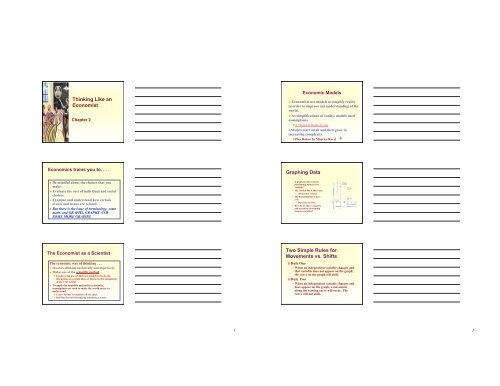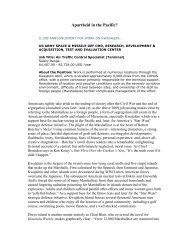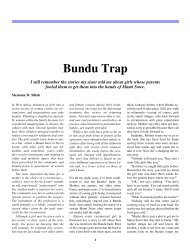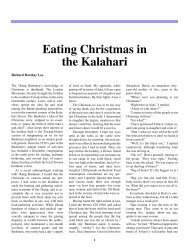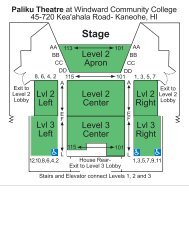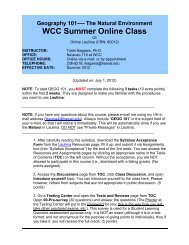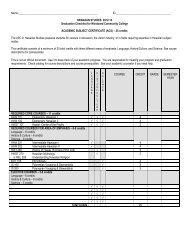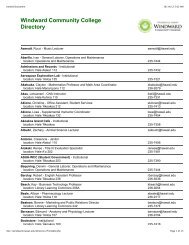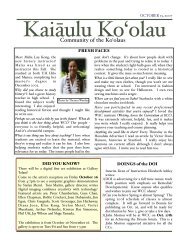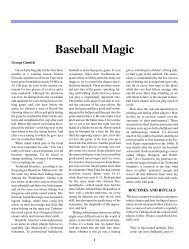Chapter 2-Thinking Like an Economist
Chapter 2-Thinking Like an Economist
Chapter 2-Thinking Like an Economist
You also want an ePaper? Increase the reach of your titles
YUMPU automatically turns print PDFs into web optimized ePapers that Google loves.
<strong>Thinking</strong> <strong>Like</strong> <strong>an</strong><br />
<strong>Economist</strong><br />
<strong>Chapter</strong> 2<br />
Economic Models<br />
! <strong>Economist</strong>s use models to simplify reality<br />
in order to improve our underst<strong>an</strong>ding of the<br />
world.<br />
! As simplifications of reality, models need<br />
assumptions.<br />
!A Model of Boids Flying<br />
!Models start small <strong>an</strong>d then grow in<br />
increasing complexity.<br />
!Play Bolero by Maurice Ravel<br />
Economics trains you to. . . .<br />
! Be mindful about the choices that you<br />
make.<br />
! Evaluate the cost of individual <strong>an</strong>d social<br />
choices.<br />
! Examine <strong>an</strong>d underst<strong>an</strong>d how certain<br />
events <strong>an</strong>d issues are related.<br />
! But there is the issue of terminology, some<br />
math, <strong>an</strong>d GRAPHS, GRAPHS AND<br />
SOME MORE GRAPHS!<br />
Graphing Data<br />
" A graph reveals a causal<br />
relationship between two<br />
variables.<br />
" The vertical line is the y-axis.<br />
• Independent variable.<br />
" The horizontal line is the x-<br />
axis.<br />
• Dependent variable.<br />
" How do we show a negative<br />
<strong>an</strong>d a positive relationship<br />
between variables?<br />
The <strong>Economist</strong> as a Scientist<br />
The economic way of thinking . . .<br />
! Involves thinking <strong>an</strong>alytically <strong>an</strong>d objectively.<br />
! Makes use of the scientific method.<br />
! Involves the use of abstract models to focus the<br />
discussion on a main idea or theme in the complexity<br />
of the real world.<br />
! To apply the scientific method in economics,<br />
assumptions are used to make the world easier to<br />
underst<strong>an</strong>d.<br />
! Ceteris Paribus Assumption-All else equal.<br />
! Role Play Scenario-Purchasing something at a store.<br />
Two Simple Rules for<br />
Movements vs. Shifts<br />
# Rule One<br />
"When <strong>an</strong> independent variable ch<strong>an</strong>ges <strong>an</strong>d<br />
that variable does not appear on the graph,<br />
the curve on the graph will shift.<br />
# Rule Two<br />
"When <strong>an</strong> independent variable ch<strong>an</strong>ges <strong>an</strong>d<br />
does appear on the graph, a movement<br />
along the existing curve will occur. The<br />
curve will not shift.<br />
1<br />
2
Graphing Data<br />
"<strong>Economist</strong>s use three types of graphs to<br />
reveal relationships between variables. They<br />
are:<br />
" Time-series graphs<br />
" Cross-section graphs<br />
" Scatter diagrams<br />
Journal Assignment-<br />
Circular Flow Diagram<br />
# Draw a circular flow diagram.<br />
# Identify the parts of the model that correspond<br />
to the flow of goods <strong>an</strong>d services <strong>an</strong>d the flow<br />
of dollars for each of the following activities:<br />
"Sam pays a storekeeper $1 for a quart of milk.<br />
"Sam gets a quart of milk.<br />
"Sally earns $4.50 per hour working at a fast food<br />
restaur<strong>an</strong>t.<br />
"Sally works at the restaur<strong>an</strong>t.<br />
Two of the Most Basic<br />
Economic Models Are<br />
# The Circular Flow Diagram<br />
# The Production Possibilities Frontier.<br />
The Production Possibilities<br />
Frontier<br />
•Shows the various combinations of two<br />
goods that c<strong>an</strong> be produced by one firm.<br />
•Assumes two goods<br />
•Assumes fixed technology <strong>an</strong>d fixed<br />
factors of production.<br />
The Circular-Flow Diagram<br />
Firms<br />
Revenue<br />
Goods &<br />
Services sold<br />
Market for<br />
Goods<br />
<strong>an</strong>d Services<br />
Spending<br />
Goods &<br />
Services<br />
bought<br />
Households<br />
Qu<strong>an</strong>tity of<br />
Computers<br />
Produced<br />
The Production Possibilities<br />
Frontier<br />
3,000<br />
2,200<br />
2,000<br />
C<br />
A<br />
D<br />
Inputs for<br />
production<br />
Wages, rent,<br />
<strong>an</strong>d interest<br />
Market for<br />
Factors<br />
of Production<br />
Labor, l<strong>an</strong>d,<br />
<strong>an</strong>d capital<br />
Income<br />
B<br />
1,000<br />
0 300 600 700 1,000<br />
Qu<strong>an</strong>tity of<br />
Cars Produced<br />
3<br />
4
Qu<strong>an</strong>tity of<br />
Computers<br />
Produced<br />
The Production Possibilities<br />
Frontier<br />
3,000<br />
2,200<br />
2,000<br />
1,000<br />
B<br />
C<br />
A<br />
D<br />
Production<br />
possibilities<br />
frontier<br />
Microeconomics <strong>an</strong>d<br />
Macroeconomics<br />
! Microeconomics focuses on the<br />
individual parts of the economy.<br />
! How households <strong>an</strong>d firms make decisions<br />
<strong>an</strong>d how they interact in specific markets<br />
! Macroeconomics looks at the economy as<br />
a whole.<br />
! How the markets, as a whole, interact at the<br />
national level.<br />
0 300 600 700 1,000<br />
Qu<strong>an</strong>tity of<br />
Cars Produced<br />
Concepts Illustrated by the<br />
Production Possibilities Frontier<br />
! Efficiency<br />
! Tradeoffs<br />
! Opportunity Cost<br />
! Economic Growth<br />
The Essence of<br />
Microeconomics-Buyers<br />
<strong>an</strong>d Sellers<br />
Qu<strong>an</strong>tity<br />
of Computers<br />
Produced<br />
4,000<br />
3,000<br />
2,100<br />
2,000<br />
The Production<br />
Possibilities Frontier<br />
A<br />
E<br />
An outward shift<br />
in the production<br />
possibilities<br />
frontier<br />
Increase in<br />
technology to<br />
produce<br />
computers.<br />
The M<strong>an</strong>y Facets of<br />
Macroeconomics<br />
0 700 750 1,000<br />
Qu<strong>an</strong>tity of<br />
Cars Produced<br />
5<br />
6
Two Roles of <strong>Economist</strong>s<br />
!When they are trying to explain the<br />
world, they are scientists.<br />
!When they are trying to ch<strong>an</strong>ge the<br />
world, they are policymakers.<br />
Positive versus Normative<br />
Analysis<br />
! Positive statements are statements<br />
that describe the world as it is.<br />
!Called descriptive <strong>an</strong>alysis<br />
! Normative statements are<br />
statements about how the world<br />
should be.<br />
!Called prescriptive <strong>an</strong>alysis<br />
Why <strong>Economist</strong>s Agree <strong>an</strong>d<br />
Disagree<br />
! We agree on the methodology,<br />
but not on the underlying<br />
assumptions underlying<br />
incentives <strong>an</strong>d behavior.<br />
!Example-No Child Left Behind<br />
<strong>an</strong>d Test Scores.<br />
7


